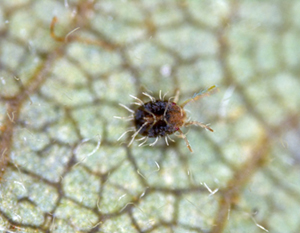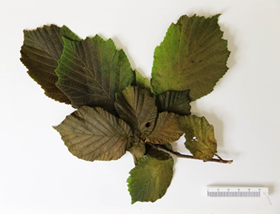Hazelnut mite
The hazelnut mite (Tetranycopsis horridus) is a sap sucking plant pest. Little research has been undertaken on this mite, so information is relatively scarce. However, there are reports that the mite has been destructive to some economic crops overseas, including hazelnut and walnut.
Description
Adult hazelnut mites are less than 0.5 mm long and are only just visible to the naked eye as tiny moving black dots. The adult is characterised by long spines on their bodies giving them a hairy appearance (Figure 1). Immature mites undergo a series of moults before reaching adulthood, leaving behind white cast skins. Eggs are red in colour and cannot be seen by the naked eye.

Feeding damage
Feeding causes leaf discoloration and conspicuous white or yellowish feeding spots on the upper surface of the leaves (Figure 2). Heavy infestations can cause whole leaves to wither and die. Both young and mature varieties of hazelnut are attacked.
Mites are found mostly on the underside of the leaf surface, along with eggs and cast skins from moulting, but will move to the upper leaf surface when densities are high. Eggs can often be found on the developing nuts and leaf bracts.

Hosts
Hazelnut (Corylus spp.) is the main host for this mite and it has been reported that some hazelnut varieties appear more susceptible than others.
The mite has also been associated with other tree species including alder (Alnus spp.), cedar (Thuja spp.), musk willow (Salix aegyptiaca), oak (Quercus spp.), pine (Pinus spp.), spruce (Picea spp.) and walnut (Juglans spp.) as well as the common bean (Phaseoulus vulgaris) and the flowering plant yarrow (Achillea spp.). The mites have also been seen in truffle orchards but have not led to any significant damage, so are considered a minor pest.
Life cycle
Hazelnut mites are mostly female and can produce offspring without mating. There can be up to five generations in one year in warmer climates. In cooler areas the mite eggs can remain dormant over winter and hatch in the spring.
Distribution
The mite has a broad geographic distribution which includes Europe (from Spain to western Russia), China, and the USA.
It was first detected in Australia in January 2016 on hazelnut trees in Victoria's north east and later on properties in outer Melbourne. In February 2016, the pest was confirmed in NSW. The widespread distribution suggests the mite may have been present in Australia for some time.
Spread
Adults and eggs can be spread by movement of infested plant material and equipment.
Other species of closely related mites can spread long distances by producing a silk thread and ‘ballooning’ into the wind although this has not been directly observed in hazelnut mites.
Spread can be minimised adhering to strict hygiene protocols for staff and visitors on farm.
Monitoring your crops regularly and sourcing plant material from reputable suppliers is good business practice.
Image credits
Agriculture Victoria
Reporting an unusual plant insect pest or disease
Report any unusual plant pest or disease immediately using our online reporting form or by calling the Exotic Plant Pest Hotline on 1800 084 881. Early reporting increases the chance of effective control and eradication.
Please take multiple good quality photos of the pests or damage to include in your report where possible, as this is essential for rapid pest and disease diagnosis and response.
Your report will be responded to by an experienced staff member, who may seek more information about the detection and explain next steps.
Report online